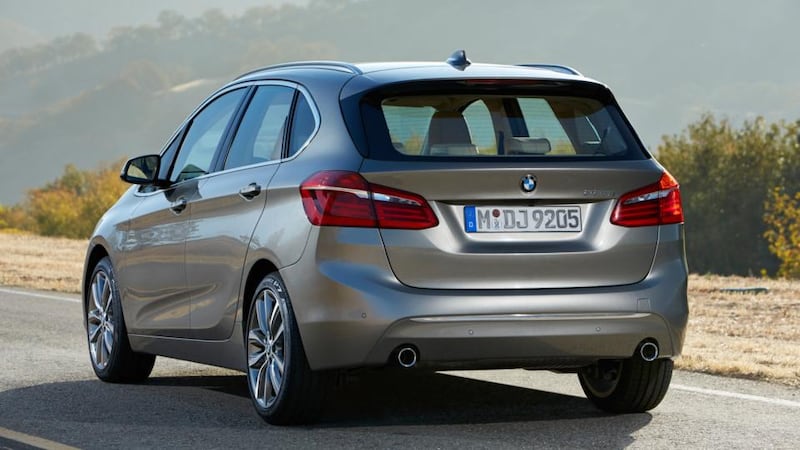You start to think the 2-Series Active Tourer is a very odd sort of BMW when some of its biggest features are its interior versatility, odds-and-ends storage and practicality.
When another of its biggest features is a system that keeps inattentive pedestrians alive by automatically braking the car in cities, you know BMW is pushing into unknown territory here, with a five-door, passenger-focused almost-MPV.
This is unknown territory for BMW’s marketing men in the same way the i3 was unknown territory for its engineers and production people. And it’s unknown territory for BMW in more ways than one.


It’s the first three-cylinder engine in any BMW with more than two wheels. It’s its first front-wheel-drive production car. It’s the first BMW that can hold a 1.5-litre drink bottle in each front door.
The 2-Series, which is to be launched as a production model at Geneva Motor Show, next month, will share its modular front-drive architecture with the new Mini, but with significant differences. For starters, it uses a longer, 2,670mm wheelbase to help stretch the rear legroom to what it calls “luxury limousine standards”.
The five-door hatch will be 4,342mm long, 1,800mm wide and 1,555mm high – so with a wider cabin than the 3-Series but an 11.3-metre turning circle.
The 2-Series Active Tourer will arrive with three models: a 218i with the 1.5-litre, turbocharged three-cylinder engine that made its debut in the Mini Cooper, a 225i that shares the Mini Cooper S’s turbocharged four-cylinder motor, and a 218d, with a four-cylinder, 2.0-litre turbodiesel.
Oddly, BMW insists on calling it a 2-Series, even though it’s front-wheel drive and uses a completely different chassis architecture and construction system from the rear-drive 2-Series coupé, the only existing 2-Series model. The Active Tourer is so different that the two cars can share none of their main engineering pieces, yet they carry the same name.
Like the new Mini
It has a lot more in common with the all-new Mini than it does with the 2-Series coupé. Their common architecture includes a sophisticated four-link rear suspension and an innovative single joint spring-strut front end with the same electromechanical steering system.
But then the Active Tourer goes its own way. It’s more than 500mm longer than the Mini Cooper hatch, rides on 175mm more wheelbase and is 73mm wider. And it’s heavier.
The Active Tourer weighs 1,320kg in its lightest (218i) form, which is 235kg more than the Cooper, even though they share the same engine and gearbox combination. The 225i is the heaviest Active Tourer, at 1,430kg – 270kg more than the Cooper S.
They have completely different philosophies, of course, because the Mini is a hatch that lives on character and cool, while the 2-Series Active Tourer is a versatile five-seat, five-door car that edges perilously close to being an MPV.
BMW insists it’s all about the practical and luxurious interior that breaks new ground for the brand. There’s something to be said for it. From its wide rear hatch, which can be opened with the optional foot-swiper, it can swallow things that are 2.4 metres long (such as the cross-country skis so beloved of BMW engineers, coincidentally).
The boot has a false floor with a couple of compartments beneath it, plus an array of hooks and nets above it. The 40:20:40 split-fold rear seat folds fully flat to boost luggage space from 468 to 1,510 litres – towards the X5’s cargo area.
It gets better as you go forwards, because the rear seat has 10mm more shoulder room than up front – and can slide forwards or backwards, as well as having an adjustable angle.
The higher-than-usual driving position is somewhere between that of a 2-Series coupé and an SUV. BMW says the car is going to be driven in cities and needs more practical visional considerations. That, and it’s easier to get in and out of.
The cabin is heavily driver focused, with the air conditioning, navigation, radio and all other controls in a horizontally layered dashboard. There’s also a head-up display.
As part of its city-conquest goal, BMW debuts a warning system that monitors pedestrians in urban streets, figures which ones are about to get hurt and warns the driver. If the driver ignores the warning, it brakes the car, even up to 60km/h, to miss the pedestrian or mitigate the impact.
It also makes city life easier by hooking the camera-based adaptive cruise control into a traffic-jam assist. If you keep one hand on the wheel, the car will do all of the pointing, going and stopping for you, all the way up to 140km/h.
Urban nature
The 225i version still gets to 100km/h in 6.8 seconds, and will hit 235km/h, but it gives away its urban nature by delivering its 350Nm of torque from just 1,250rpm.
The entry-level 218i gets the same output from its three-cylinder turbocharged petrol engine as the Mini Cooper does, so it has 100kW of power from 4,500rpm to 6,000rpm and 220Nm from 1,250rpm. It eaches 100km/h in 9.3 seconds, with a top speed of 200km/h. Its fuel economy of 4.9 litres/100km isn’t bad for a car this large inside.
A 2.0-litre, four-cylinder turbodiesel will also lead the Active Tourer charge, including 110kW of power and 330Nm of torque from 1,750rpm. It gets to 100km/h in 8.9 seconds, but its highlight is its economy: 4.1 litres/100km.
That’s the starting line-up; BMW will also release a 220i, a 220d and a 216d, which is likely to be the big seller in Ireland.
It's a brave move for BMW. If this car becomes a winner with the family set, the company will be tapping into a rich vein of future family buyers – which should help fend off Audi and Mercedes-Benz rivals.











